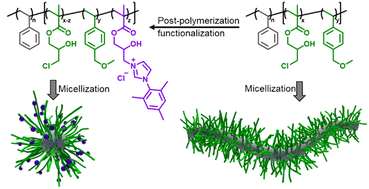Synthesis of block copolymers containing 3-chloro-2-hydroxypropyl methacrylate by NMP – a versatile platform for functionalization†
Abstract
Herein we report the preparation of polystyrene-block-poly((3-chloro-2-hydroxypropyl methacrylate)-co-(4-methoxymethylstyrene)) (PS-b-P(ClHPMA-co-MMS)) and polystyrene-block-poly((3-chloro-2-hydroxypropyl methacrylate)-co-(4-methoxymethylstyrene)-co-(3-(1-mesityl-1H-imidazolium-3-yl chloride)-2-hydroxypropyl methacrylate)) (PS-b-P(ClHPMA-co-MMS-co-MesIHPMA)) block copolymers and the corresponding micelles formed in methanol (MeOH) as selective solvent. Utilizing nitroxide-mediated polymerization (NMP), the homopolymerization of ClHPMA and its copolymerization with styrene, 4-methoxymethylstyrene (MMS), and 9-(4-vinylbenzyl)-9H-carbazole (VBC) as controlling comonomers were studied. Therefore, in a series of kinetic investigations the impact of different styrenic comonomers, monomer concentrations, monomer to initiator ratios, and reaction temperatures on polymerization control was investigated. In kinetic studies different monomer concentrations and solvents for the block extension of a polystyrene (PS) macroinitiator with ClHPMA and MMS were selected to optimize reaction conditions. In the next step a PS-b-P(ClHPMA-co-MMS) block copolymer was synthesized and functionalized by nucleophilic substitution of the side chain chlorine moieties with MesI. Micellization of both PS-b-P(ClHPMA-co-MMS) and PS-b-P(ClHPMA-co-MMS-co-MesIHPMA) block copolymers was conducted via solvent exchange with methanol and methanol/water mixture (9 : 1). Structure and size of the nanoaggregates were investigated with dynamic light scattering (DLS) and transmission electron microscopy (TEM) verifying an influence of the micellar preparation pathway and the block copolymer composition on the final morphology.



 Please wait while we load your content...
Please wait while we load your content...